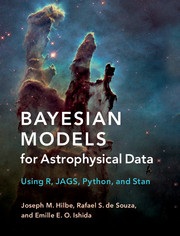Book contents
- Frontmatter
- Dedication
- Contents
- Preface
- 1 Astrostatistics
- 2 Prerequisites
- 3 Frequentist vs. Bayesian Methods
- 4 Normal Linear Models
- 5 GLMs Part I – Continuous and Binomial Models
- 6 GLMs Part II – Count Models
- 7 GLMs Part III – Zero-Inflated and Hurdle Models
- 8 Hierarchical GLMMs
- 9 Model Selection
- 10 Astronomical Applications
- 11 The Future of Astrostatistics
- Appendix A Bayesian Modeling using INLA
- Appendix B Count Models with Offsets
- Appendix C Predicted Values, Residuals, and Diagnostics
- References
- Index
- Plate section
- References
7 - GLMs Part III – Zero-Inflated and Hurdle Models
Published online by Cambridge University Press: 11 May 2017
- Frontmatter
- Dedication
- Contents
- Preface
- 1 Astrostatistics
- 2 Prerequisites
- 3 Frequentist vs. Bayesian Methods
- 4 Normal Linear Models
- 5 GLMs Part I – Continuous and Binomial Models
- 6 GLMs Part II – Count Models
- 7 GLMs Part III – Zero-Inflated and Hurdle Models
- 8 Hierarchical GLMMs
- 9 Model Selection
- 10 Astronomical Applications
- 11 The Future of Astrostatistics
- Appendix A Bayesian Modeling using INLA
- Appendix B Count Models with Offsets
- Appendix C Predicted Values, Residuals, and Diagnostics
- References
- Index
- Plate section
- References
Summary
Zero-inflated models are mixture models. In the domain of count models, zero-inflated models involve the mixtures of a binary model for zero counts and a count model. It is a mixture model because the zeros are modeled by both the binary and the count components of a zero-inflated model.
The logic of a zero-inflated model can be expressed as
Pr(Y = 0) : Pr(Bin = 0) + [1 − Pr(Bin = 0)] × Pr(Count = 0)
Pr(Y ≥ 0) : 1 − Pr(Bin = 0) + PDFcount
Thus, the probability of a zero in a zero-inflated model is equal to the probability of a zero in the binary model component (e.g., the logistic) plus one minus the probability of a zero in the binary model times the probability of a zero count in the count model component. The probability that the response is greater than or equal to zero (as in e.g. the Poisson model) is equal to one minus the probability of a zero in the binary component plus the count model probability distribution. The above formulae are valid for all zero-inflated models.
Bayesian Zero-Inflated Poisson Model
We can apply the above formulae for a zero-inflated Poisson–logit model. The count component is a Poisson model and the binary component is a Bernoulli logistic model. Aside from the Poisson PDF, the key formulae for the zero-inflated Poisson–logit model, generally referred to as ZIP, include the probability of zero for a logistic model, 1/[1 + exp(xβ)], and the probability of a zero Poisson count, exp(−μ). Given that μ = exp(xβ), the probability of a zero Poisson count with respect to the linear predictor xβ is exp[− exp(xβ)]. The probability of all but zero counts is 1 − Pr(0), or 1 − exp[− exp(xβ)] or 1 − exp(−μ). The zero-inflated Poisson–logit model log-likelihood is given by the following expressions:[…]
- Type
- Chapter
- Information
- Bayesian Models for Astrophysical DataUsing R, JAGS, Python, and Stan, pp. 184 - 214Publisher: Cambridge University PressPrint publication year: 2017



